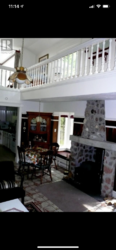Wet behind the ear (not WETT) newbie question. I purchased a cottage with an exceptional stone chimney and stainless insert which according to the WETT tech I hired to certify has a wood stove that needs replacing.
I started my search this morning and within an hour was advised by a reputable retailer and installer that this is considered an alcove, and that the ceiling clearance outlined in the specifications of the Drolet 1800 that was recommended is a measurement from the floor to the bottom of the mantle and not to the bottom of the catwalk above.
I cannot locate a definition of a wood stove alcove to determine is correct.
I do not have an exact measurement yet to the mantle but would estimate it to have been 5’.
can anyone shed some (fire)light on this?
I started my search this morning and within an hour was advised by a reputable retailer and installer that this is considered an alcove, and that the ceiling clearance outlined in the specifications of the Drolet 1800 that was recommended is a measurement from the floor to the bottom of the mantle and not to the bottom of the catwalk above.
I cannot locate a definition of a wood stove alcove to determine is correct.
I do not have an exact measurement yet to the mantle but would estimate it to have been 5’.
can anyone shed some (fire)light on this?


